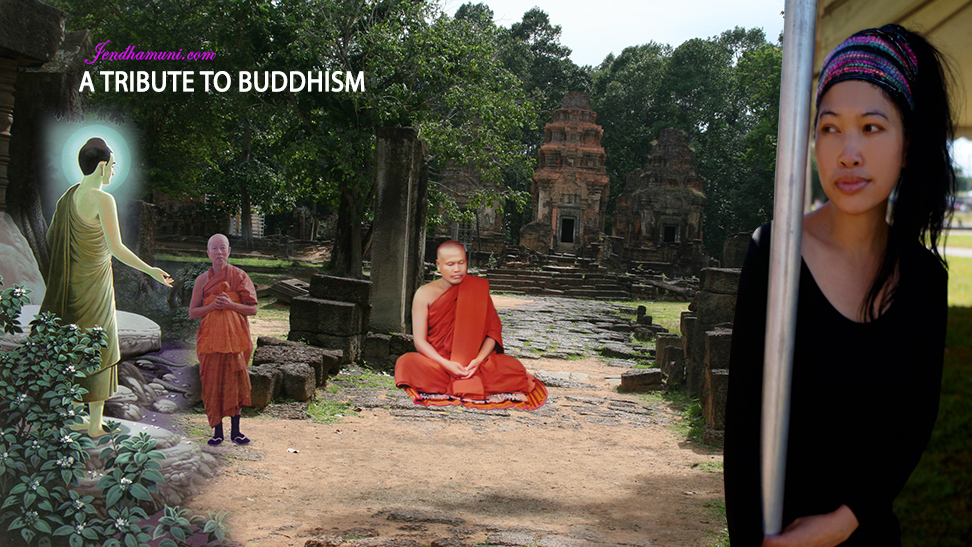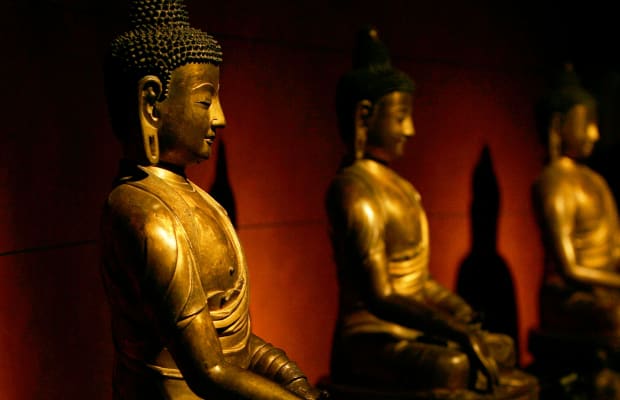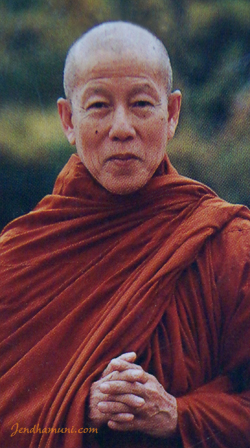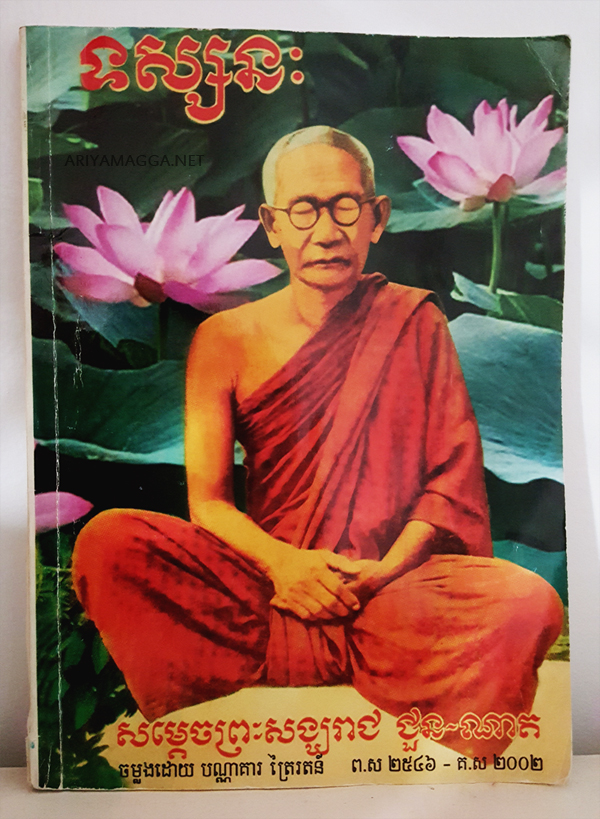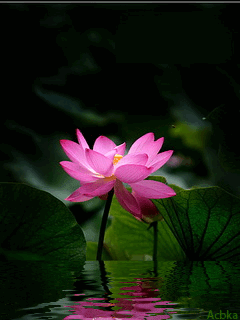-
1 January 7, 2021
-
ពុទ្ធបាទប្រាំឋាន
Comment January 5, 2021ពុទ្ធបាទ៥ឋាន
ព្រះទសពលញាណ ជិតចូលនិព្វាន ទ្រង់មានមេត្តា
ករុណាសាយសព្វ គន្ធព្វអសុរា គ្រុឌ នាគ ទេវតា
សព្វមនុស្ស ប្រុសស្រី។ទ្រង់ប្រោសប្រទាន ព្រះបាទប្រាំឋាន ទុកឱ្យវន្ទា
ព្រះបាទមួយក្នុង ចមចុងគិរី សុវណ្ណមាលី
ជាទីកំណត់។ព្រះបាទសោភា មួយស្ថិតនៅនា សុវណ្ណបព៌ត
មួយស្ថិតនៅនា លង្កាប្រាកដ លើភ្នំសន្មត
សុមនកូដគាប់។ព្រះបាទសួស្តី មួយនៅបុរី យោនកស្រេចស្រាប់
អ្នកនគរស្រុក យកទុកសម្រាប់ រកគ្រឿងប្រដាប់
ធ្វើពុទ្ធបូជា។ព្រះបាទសោភី មួយស្ថិតនៅទី ស្ទឹងនម្មទា
ព្រះអង្គជាន់ទុក លើភក់ពសុធា ទុកឱ្យមច្ឆា
ក្រួញក្រាបអភិវន្ទ។ព្រះត្រៃលោកនាថ ទុកស្នាមព្រះបាទ ប្រាំឋានសោភ័ណ
តំណាងព្រះអង្គ ឱ្យគង់ប្រាំពាន់ វស្សាគ្រប់គ្រាន់
ទើបស្តេចនិព្វាន។ឱអស់យើងខ្ញុំ អភ័ព្វពេកពុំ ទាន់ព្រះទ្រង់ញាណ
ទាន់តែសាសនា បាទាប្រាំឋាន នោះសោតពុំបាន
ទៅទៀបឱ្យយល់។សូមក្រួញក្រាបថ្វាយ បង្គំពីឆ្ងាយ តម្រង់ឆ្ពោះដល់
ព្រះបាទប្រាំឋាន កល្យាណនិមល សូមមានមង្គល
តេជៈជោគជ័យ។សូមឈ្នះលោភោ ទោសោមោហោ ឧបទ្រពចង្រៃ
គ្រោះថ្នាក់ទុក្ខសោក ទាំងរោគាភ័យ សូមសុខសព្វថ្ងៃ
ដរាបទៅហោង។ -
If in our daily lives we can smile
3 January 3, 2021If a child smiles, if an adult smiles, that is very important. If in our daily lives we can smile, if we can be peaceful and happy, not only we, but everyone will profit from it. If we really know how to live, what better way to start the day than with a smile? Our smile affirms our awareness and determination to live in peace and joy. The source of a true smile is an awakened mind. ~ Thich Nhat Hanh
-
The empty mind – the pure mind
Comment January 3, 2021The empty mind – the pure mind – is not a blank, zero-land, where you’re not feeling or caring about anything. It’s an effulgence of the mind. It’s a brightness that is truly sensitive and accepting. It’s an ability to accept life as it is. When we accept life as it is, we can respond appropriately to the way we’re experiencing it, rather than just reacting out of fear and aversion. — Ajahn Sumedho
-
When you try to get rid of fear or anger, what happens?
2 January 2, 2021When you try to get rid of fear or anger, what happens? You just get restless or discouraged and have to go eat something or smoke or drink or do something else. But if you wait and endure restlessness, greed, hatred, doubt, despair, and sleepiness, if you observe these conditions as they cease and end, you will attain a kind of calm and mental clarity, which you will never achieve if you’re always going after something else. ~ Ajahn Sumedho
-
Mind’s ultimate nature
Comment January 2, 2021Mind’s ultimate nature, emptiness endowed with vividness,
I was told is the real Buddha.
Recognizing this should help me
Not to be stuck with thoughts of hierarchy.Mind’s ultimate nature, its emptiness aspect,
I was told is the real Dharma.
Recognizing this should help me
Not to be stuck with thoughts of political correctness.Mind’s ultimate nature, its vivid aspect,
I was told is the real Sangha.
Recognizing this should help me
Not to be stuck with thoughts of equal rights.One cannot disassociate emptiness from vividness.
This inseparability I was told is the Guru.
Recognizing this should help me
Not to be stuck with depending on chauvinist lamas. Continue reading -
Chabbaggiya Bhikkhu Vatthu
Comment January 2, 2021Verse 130: All are afraid of the stick, all hold their lives dear. Putting oneself in another’s place, one should not beat or kill others.
The Story of a Group of Six Bhikkhus
While residing at the Jetavana monastery, the Buddha uttered Verse (130) of this book, with reference to a group of six bhikkhus.
After coming to blows the first time, the same two groups of bhikkhus quarrelled again over the same building. As the rule prohibiting beating others had already been laid down, the group of six threatened the other group with upraised hands. The group of seventeen, who were junior to the chabbaggis, cried out in fright. The Buddha hearing about this laid down the disciplinary rule forbidding the raising of hands in threat.
Then the Buddha spoke in verse as follows:
Verse 130: All are afraid of the stick, all hold their lives dear. Putting oneself in another’s place, one should not beat or kill others.
Dhammapada Verse 130
Chabbaggiya Bhikkhu VatthuSabbe tasanti dandassa
sabbesam jivitam piyam
attanam upamam katva
na haneyya na ghataye.Source: Tipitaka
-
ទស្សនៈសម្តេចព្រះសង្ឃរាជ ជោតញ្ញាណោ ជួន ណាត
1 January 2, 2021១-មនុស្សល្ងង់ លង់នឹងអំនួត
២-មនុស្សឆ្កួត លង់នឹងអំណាច
៣-មនុស្សកាច លង់នឹងកម្លាំង
៤-មនុស្សពូកែចម្បាំង លង់នឹងអាវុធ
៥-មនុស្សមោះមុត លង់នឹងចំណេះវិជ្ជា ។
៦-បើឥតគំនិតងងឹងតលុះមរណា
៧-បើឥតសិក្សាល្ងង់លុះក្ស័យ ។— អានដោយ សុស ចិន្តាមុនី
-
The Buddha and His Dhamma
1 January 1, 2021Buddhism originated with an Indian prince known as the Buddha, who taught in Northeast India in the fifth century BC. Two centuries later, with the support of the Emperor Asoka, Buddhism spread over the greater part of India and from there traveled the full breadth of the Asian continent. In several tidal waves of missionary zeal it rose up from its Indian homeland and inundated other regions, offering the peoples among whom it took root a solid foundation of faith and wisdom upon which to build their lives and a source of inspiration towards which to direct their hopes. At different points in history Buddhism has commanded followings in countries as diverse geographically, ethnically, and culturally as Afghanistan and Japan, Siberia and Cambodia, Korea and Sri Lanka; yet all have looked towards the same Indian sage as their master.
Though for historical reasons Buddhism eventually disappeared from India by about the twelfth century, before it vanished it had profoundly transformed Hinduism. In our own time Indian thinkers as different as Swami Vivekananda, Tagore, Gandhi, and Nehru have looked upon the Buddha as a model. In the twentieth century, too, while Buddhism has lost much of its following in the East, it has begun to have a growing impact on an increasing number of people in the West, and in its own quiet way it is sending down firm roots in several countries of the Western hemisphere. Continue reading
-
Angulimala — The Murderer Who Became a Saint
Comment January 1, 2021King Pasenadi’s chaplain was a learned but superstitious Brahmin named Bhaggava Gagga. It was his job to cast horoscopes, advise about the best time to embark on various projects and ward off evil influences with spells and mantras. He was filled with joy when his wife gave birth to a boy, but when the baby’s horoscope was drawn up, his joy turned to dread. The horoscope indicated that the boy would grow up with criminal tendencies. Filled with superstitious fear, the parents decided to name the boy Ahimsaka, ‘Harmless’ in the hope that this would counter the influence of the stars. “The boy grew up into a fine youth who was good at his studies and obedient to his parents. But to make sure that the boy would never turn bad, they constantly stressed to him the importance of obeying them and doing what he was told.
Eventually, he left home for Taxila to do his higher studies. In those days, young Brahmins would go to Taxila and live in the house of a learned Brahmin to learn traditional lore and in return, work in his home. The relationship would be like that between father and son. Ahimsaka was a particularly obedient student which earned him special attention from his teacher but it also created jealousy in the other students. They decided to try to turn the teacher against Ahimsaka. According to plan, they went one by one to the teacher and whispered that his favourite student was trying to usurp his position. At first the teacher dismissed this as nonsense, but gradually the seeds of doubt were sown, and they eventually sprouted into suspicion and the teacher became convinced of Ahimsaka’s hostility to him. “This young man is strong in body and quite capable of doing me harm. I must get rid of him and make sure he never comes back,” he thought to himself. One day, the teacher called Ahimsaka and said: “You have successfully finished your studies, now you must bring me my fee.” “Certainly,” said Ahimsaka. ” What do you demand as your fee?” “You must bring me a thousand first fingers from the human hand.” “Surely you don’t require this of me?” responded the horrified Ahimsaka. “You have taken from me and in return you must now do my bidding. Go now and bring a thousand fingers.” The teacher’s hope was, of course, that in the process of carrying out this task Ahimsaka would be killed and he would never have to see him again. Continue reading

